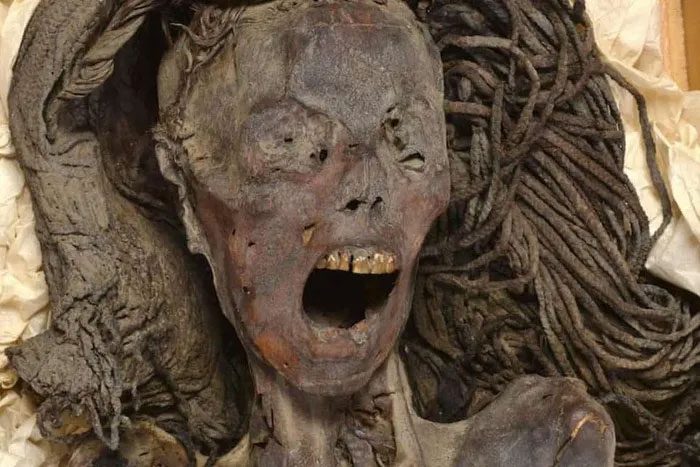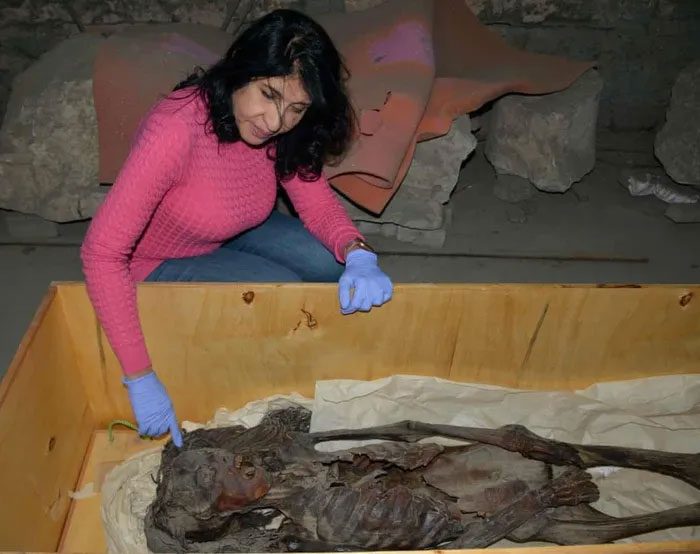Some Egyptian mummies have faces that appear to scream. Researchers believe that these individuals may have died in agony, and their wide-open mouths could represent “punishment.”
The question of why an Egyptian mummy has a screaming face resembling Edvard Munch’s painting The Scream has puzzled researchers for a long time. Now, a research team is getting closer to an answer, suggesting that the woman who was mummified likely died in pain, according to The Guardian.

Many researchers are trying to explain the screaming face of the Egyptian mummy.
This woman is believed to have been buried around 3,500 years ago and was discovered in 1935 inside a wooden sarcophagus beneath the tomb of Senmut, the great architect during the reign of female Pharaoh Hatshepsut. Archaeologists also uncovered a burial chamber for Senmut’s mother, Hat-Nufer, along with individual tombs for her relatives.
Dr. Sahar Saleem, a professor of radiology at Cairo University, stated: “Although no name is inscribed on the mummy, it is likely that this was a close family member who shared the eternal resting place with this family.”
Searching for Answers
Dr. Saleem and co-author Dr. Samia El-Merghani explained that they used computed tomography (CT) technology to “virtually dissect” the mummy, along with techniques including X-ray diffraction analysis to study the skin, hair, and long black wig.
The research team noted that the mummy was well-preserved, estimating that the woman stood about 1.55 meters tall when alive. The CT scans provided additional details, revealing that she passed away around the age of 48 and had mild arthritis.
However, the researchers found no signs of incisions for embalming, and all her internal organs remained intact within the mummy.
“This surprises me because the classical embalming method in the New Kingdom of Egypt (1550-1069 BC) involved removing all internal organs except for the heart,” Dr. Saleem noted.

The buried woman wore two beetle rings made of silver and gold.
In middle-class and impoverished settings, rudimentary embalming processes might retain internal organs. However, this was not the case for the mummy being studied.
The woman was not only buried wearing two beetle rings made of silver and gold, but researchers also discovered that the embalming materials included cypress resin and frankincense—expensive imported components that could aid in preserving the body.
Analyses revealed the presence of cypress and myrrh on the woman’s hair, while the wig was made from braided date palm fibers and showed traces of cypress, frankincense, and various minerals. According to Dr. Saleem, these substances could stiffen the fibers and give the wig its sleek black color.
The researchers believe these findings not only provide insights into the embalming process, wig-making, and trade in embalming materials in ancient times but also indicate that the woman’s open mouth was not due to careless embalmers.
Instead, the research team proposed that the woman’s expression might result from a rare form of post-mortem stiffening (rigor mortis).
“We believe the woman’s wide-open mouth could be due to a painful death or emotional stress, with rigor mortis causing her face to freeze at the moment of death. The embalmers could not close her mouth and decided to embalm the stiffening body before it decayed,” Dr. Saleem explained.
The “Screaming” Mummies
However, the cause of death remains unclear. Researchers also noted that some other experts suggest that the screaming expression could be the result of the burial process or changes after death.
Salima Ikram, a professor at the American University in Cairo, disagrees with the research team’s explanation.
“I don’t really think that this rigor mortis is something the embalmers intended to preserve forever. Therefore, I think the expression comes from something else,” she stated.
The professor added that the drying process during embalming takes 40 days. “Surely they (the embalmers) could rearrange the features of the body during that time,” Ikram said.

Dr. Sahar Saleem studies the “screaming woman” mummy.
Dr. Stuart Hamilton, a forensic researcher, mentioned that there has been debate about post-mortem stiffening, but no reasonable explanations have yet been found. “I accept that this idea exists, although it is certainly controversial,” he said. However, the forensic researcher added that it is unnecessary to complicate explanations: “I think the mouth just opened and ultimately stayed that way.”
While rare, this is not the only “screaming” mummy. Dr. Saleem and her colleagues previously studied the remains of the individual believed to be Prince Pentawere—the son of Pharaoh Ramesses III. Prince Pentawere was implicated in a conspiracy to kill his father.
Dr. Saleem stated: “The embalmers did not close his mouth. That could be a form of punishment, forcing him to scream forever.”
The remains of Princess Meritamun, thought to be the sister of Pharaoh Ahmose—who reigned from around 1550 to 1525 BC—also exhibit a similar expression.
Dr. Saleem and her colleagues noted that their previous research indicated Meritamun died from a sudden and severe heart attack. “The widely open mouth could be a natural jaw phenomenon maintained by muscle rigidity after death—also known as rigor mortis—preventing the embalmers from closing her mouth,” Dr. Saleem explained.


















































